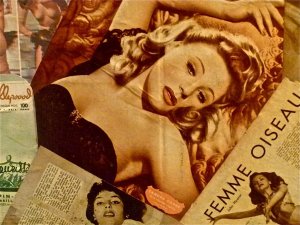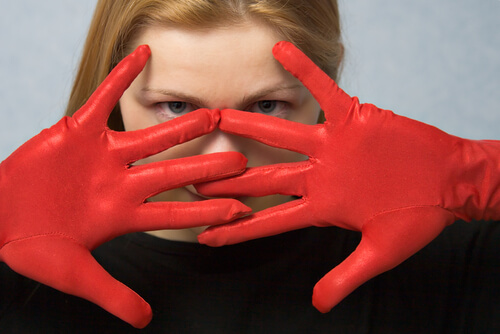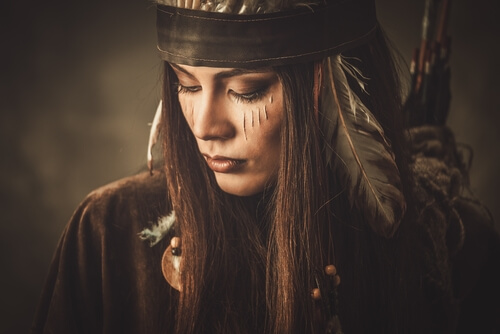The Myth of the Femme Fatale

The so-called “fatal woman” is a kind of “devourer of men.” She is both fascinating and terrible all at once.
Although there are tales of characters like this throughout the mythology of Ancient Greece, this myth really took hold towards the end of the 19th century.
The appearance of the “fatal woman” coincided with the the emergence of the feminist movement. Over time, however, the myth has evolved. In current times, the myth of the femme fatale has transformed into something more like an advertising prototype.
What characterizes this figure is a kind of beauty that is both enigmatic and threatening, but most definitely attractive. She not only seduces, but hypnotizes. She makes men fall to their knees at her feet. However, her only purpose is to destroy them.
The myth corresponds to what psychoanalysis calls a “hysterical complex“. This phrase describes a person who displays hysterical or histrionic behavior.
“For me, love means struggle, great lies, and a couple slaps in the face.”
-Edith Piaf-

The myth of femme fatale and misogynistic stereotypes
Before the appearance of romanticism (and of the female liberation/feminist movement), women barely had any kind of representation in culture. There were three basic, established stereotypes: the wife and mother, the mystic/the witch, and the prostitute.
With the feminist movement, women began to be seen as a threat. Not only did they begin to make their voices heard in many different social environments, they also became the messengers of a whole new attitude.
Through this process of social evolution and revolution, the myth of the “femme fatale” emerged. It initially appeared in literature. Many novels of the time latched on to this new side of women that, overall, involved danger. In the stories of these novels, the men always ended up being the victims.
It was in the 1940’s that the character of the “femme fatale” took to the screen and began appearing in movies. It was the period of incredible divas, who came to be defined as “vampiresses”.
The very fact that these beautiful women were compared to vampires is clear evidence that they were perceived as the messengers of something monstrous. With them lay the possibility that they would “suck” the life out of men and drive them to their own destruction.
During that era, the “fatal woman” was not only a figure, but was also identifiable by a set of psychological traits. The femme fatale was an imperturbable, calculating, and essentially insensitive woman. Her greatest strength resided in the fact that she was capable of making men fall in love with her, without actually falling in love with them. Her interests were more practical: money and power.
The femme fatale was basically the female version of the classic “Don Juan.”
From temptress to “top model”
During the second half of the twentieth century, and the twenty-first century so far, the image of the typical femme fatale has taken a turn in movies, advertising, and even literature. In reality, the myth was transformed into a cliche.
The “incredibly attractive” woman is now embodied in the figure of the “top model.” The majority of images in advertising include this side of femininity: the perverse and evil woman, but an irresistible temptress.
Additionally, the more this image of females appears, the more masculine it becomes. The female warrior has been proposed as a prototype of what is attractive. She is a kind of contemporary Amazon woman who completely shares the values of the warrior.

The character of this woman is hyper-sexualized, determined, and defiant. She is represented as if she were constantly in pursuit of conquering something relevant to the masculine world. The femme fatale of today is an important executive, conspirator, politician, soldier, athlete, etc…
This “fatal woman” competes on the same level as men. However, in the style of the classic James Bond, she uses her attractive physique and ability to seduce to her advantage, using them to get what she wants in difficult situations.
The myth of the femme fatale no longer carries with it the “mysterious beauty” of those women of the past. Now, the stereotype is much more rigid. Her body must be perfect and toned, she has “European” features (skin color is irrelevant), prominent lips, etc…
The contemporary femme fatale not only strives to be an object of desire for men, but also proposes to be an ideal model for other women.
Therefore, the femme fatale is shown as dominant, with a intimidating, independent, and, of course, beautiful and irresistible personality. This is the case in movies, despite the fact that she has lived deep in some jungle for a year, fighting to survive. She is also a rebel and almost always exhibits the latest fashion trends, regardless of her situation.
The femme fatale of today, however, has the same problem as men from all eras seem to have: the demand to show vulnerability. The inability to do that loses them the possibility of experiencing how sweet tenderness in its totality can be.
Image courtesy of Antonio Marin Segovia
The so-called “fatal woman” is a kind of “devourer of men.” She is both fascinating and terrible all at once.
Although there are tales of characters like this throughout the mythology of Ancient Greece, this myth really took hold towards the end of the 19th century.
The appearance of the “fatal woman” coincided with the the emergence of the feminist movement. Over time, however, the myth has evolved. In current times, the myth of the femme fatale has transformed into something more like an advertising prototype.
What characterizes this figure is a kind of beauty that is both enigmatic and threatening, but most definitely attractive. She not only seduces, but hypnotizes. She makes men fall to their knees at her feet. However, her only purpose is to destroy them.
The myth corresponds to what psychoanalysis calls a “hysterical complex“. This phrase describes a person who displays hysterical or histrionic behavior.
“For me, love means struggle, great lies, and a couple slaps in the face.”
-Edith Piaf-

The myth of femme fatale and misogynistic stereotypes
Before the appearance of romanticism (and of the female liberation/feminist movement), women barely had any kind of representation in culture. There were three basic, established stereotypes: the wife and mother, the mystic/the witch, and the prostitute.
With the feminist movement, women began to be seen as a threat. Not only did they begin to make their voices heard in many different social environments, they also became the messengers of a whole new attitude.
Through this process of social evolution and revolution, the myth of the “femme fatale” emerged. It initially appeared in literature. Many novels of the time latched on to this new side of women that, overall, involved danger. In the stories of these novels, the men always ended up being the victims.
It was in the 1940’s that the character of the “femme fatale” took to the screen and began appearing in movies. It was the period of incredible divas, who came to be defined as “vampiresses”.
The very fact that these beautiful women were compared to vampires is clear evidence that they were perceived as the messengers of something monstrous. With them lay the possibility that they would “suck” the life out of men and drive them to their own destruction.
During that era, the “fatal woman” was not only a figure, but was also identifiable by a set of psychological traits. The femme fatale was an imperturbable, calculating, and essentially insensitive woman. Her greatest strength resided in the fact that she was capable of making men fall in love with her, without actually falling in love with them. Her interests were more practical: money and power.
The femme fatale was basically the female version of the classic “Don Juan.”
From temptress to “top model”
During the second half of the twentieth century, and the twenty-first century so far, the image of the typical femme fatale has taken a turn in movies, advertising, and even literature. In reality, the myth was transformed into a cliche.
The “incredibly attractive” woman is now embodied in the figure of the “top model.” The majority of images in advertising include this side of femininity: the perverse and evil woman, but an irresistible temptress.
Additionally, the more this image of females appears, the more masculine it becomes. The female warrior has been proposed as a prototype of what is attractive. She is a kind of contemporary Amazon woman who completely shares the values of the warrior.

The character of this woman is hyper-sexualized, determined, and defiant. She is represented as if she were constantly in pursuit of conquering something relevant to the masculine world. The femme fatale of today is an important executive, conspirator, politician, soldier, athlete, etc…
This “fatal woman” competes on the same level as men. However, in the style of the classic James Bond, she uses her attractive physique and ability to seduce to her advantage, using them to get what she wants in difficult situations.
The myth of the femme fatale no longer carries with it the “mysterious beauty” of those women of the past. Now, the stereotype is much more rigid. Her body must be perfect and toned, she has “European” features (skin color is irrelevant), prominent lips, etc…
The contemporary femme fatale not only strives to be an object of desire for men, but also proposes to be an ideal model for other women.
Therefore, the femme fatale is shown as dominant, with a intimidating, independent, and, of course, beautiful and irresistible personality. This is the case in movies, despite the fact that she has lived deep in some jungle for a year, fighting to survive. She is also a rebel and almost always exhibits the latest fashion trends, regardless of her situation.
The femme fatale of today, however, has the same problem as men from all eras seem to have: the demand to show vulnerability. The inability to do that loses them the possibility of experiencing how sweet tenderness in its totality can be.
Image courtesy of Antonio Marin Segovia
This text is provided for informational purposes only and does not replace consultation with a professional. If in doubt, consult your specialist.







